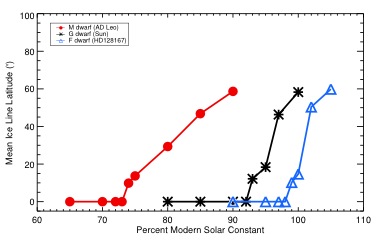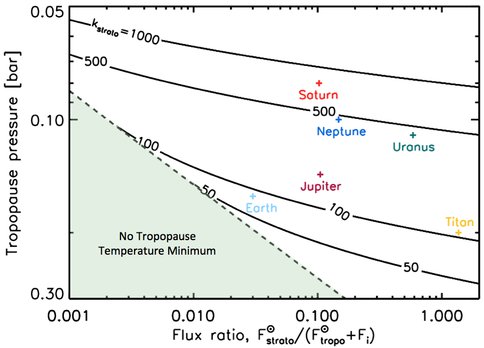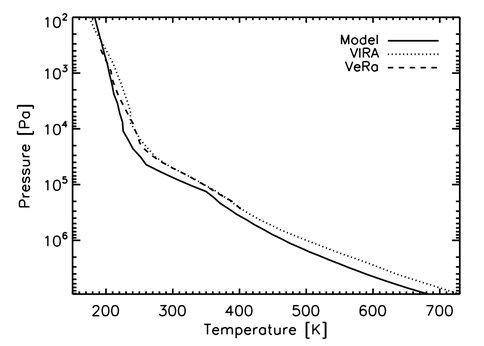2013 Annual Science Report
 VPL at University of Washington
Reporting | SEP 2012 – AUG 2013
VPL at University of Washington
Reporting | SEP 2012 – AUG 2013
Climates and Evolution of Extrasolar Terrestrial Planets
Project Summary
Planetary climate results from the interplay of a large number of different physical processes, including radiative heating and cooling, advection and dynamics, latent heating and cloud effects, atmosphere-interior interactions, and the presence of life. Atmospheres and climate then evolve through time due to interplay between these processes and longer-term effects, such as atmospheric escape, orbital evolution, and other dynamical interactions. Since planetary climate determines surface habitability, we can better understand how planets maintain habitability over long time periods by studying and modeling the large network of interactions that determine the atmospheric state of a planet and how it changes through time.
Project Progress
This year we made significant progress on the development and use of a hierarchy of planetary climate models, which can be used as tools to understand the factors affecting terrestrial planetary climate, and how surface habitability may evolve over time. Team members Robinson and Catling derived an analytic radiative-convective model for planetary atmospheres (Robinson and Catling 2012), which is an intuitive tool for gaining insight into fundamental processes in planetary climate. This model was recently used to explain why Earth, Jupiter, Saturn, Titan, Uranus, and Neptune all share a common tropopause temperature minimum in their atmosphere at 0.1 bar pressure (Robinson and Catling 2013). The explanation lies in the physics of infrared radiative transport, and should apply to countless worlds outside the Solar System. Furthermore, the assumption of a 0.1 bar tropopause can be used to help constrain surface pressure or surface temperature on an exoplanet, the combination of which determine habitability.
Shields, Meadows, Bitz, Pierrehumbert and collaborators used a hierarchy of climate models to explore the effect of the interaction between the parent star’s radiation and the planet’s wavelength dependent reflectivity (from surface ice and snow, and atmospheric absorption) on planetary climate. Their results indicate that planets orbiting cooler, redder (M-dwarf) stars are less sensitive to decreases in stellar insolation (as shown in Figure 2 below), and episodes of low-latitude glaciation may be less likely to occur on M-dwarf planets in the habitable zone than on planets orbiting stars with high visible and near-UV output. This is due to absorption of near-infrared radiation by lower-albedo surface ice and atmospheric absorption by CO2 and water-vapor. However, at the outer edge of the habitable zone, high levels of CO2 mask the ice-albedo effect, leaving the traditional limit of the outer edge of the HZ unaffected by the spectral dependence of ice and snow albedo (Shields et al., 2013). Ongoing simulations also indicate that the amount of increased stellar flux required to melt a planet out of a snowball state is highly sensitive to host star SED. We find that a distant frozen M-dwarf planet orbiting beyond the outer edge of its star’s habitable zone without a continuously active carbon cycle is likely to melt more easily out of global ice cover as its host star ages and its luminosity increases (Shields et al., in prep).
In ongoing development in this task, Robinson, Crisp, and Meadows have continued to develop a new, accurate and versatile 1-D model of terrestrial planetary climate, which is based on the VPL’s line-by-line radiative transfer model, SMART (developed by D. Crisp, see Meadows and Crisp 1996). By computing how radiative fluxes evolve due to changes in the atmospheric state, this new model can both accurately and quickly determine atmospheric thermal equilibrium states (Robinson and Crisp, in prep.). The model is currently being validated against the challenging problem of Venus’ climate. As part of this effort, Gao et al. (in press) implemented and validated the latest version of the Community Aerosol and Radiation Model for Atmospheres (CARMA), and used this model to successfully simulate the clouds of Venus. This sophisticated cloud microphysical model will now be used to simulate clouds in the VPL 1-D Climate Model. Team member Brown contributed significantly to the release of HITRAN 2012 gas absorption database (Rothman et al. 2013) which is used as input to all our radiative and climate modeling efforts. Pierrehumbert and colleagues started work on modifying the Princeton FMS dynamical core to become a generalized 3-D climate model for exoplanet studies.

Publications
-
Gao, P., Zhang, X., Crisp, D., Bardeen, C. G., & Yung, Y. L. (2014). Bimodal distribution of sulfuric acid aerosols in the upper haze of Venus. Icarus, 231, 83–98. doi:10.1016/j.icarus.2013.10.013
-
Robinson, T. D., & Catling, D. C. (2012). AN ANALYTIC RADIATIVE-CONVECTIVE MODEL FOR PLANETARY ATMOSPHERES. The Astrophysical Journal, 757(1), 104. doi:10.1088/0004-637x/757/1/104
-
Robinson, T. D., & Catling, D. C. (2013). Common 0.1 bar tropopause in thick atmospheres set by pressure-dependent infrared transparency. Nature Geosci, 7(1), 12–15. doi:10.1038/ngeo2020
-
Rothman, L. S., Gordon, I. E., Babikov, Y., Barbe, A., Chris Benner, D., Bernath, P. F., … Wagner, G. (2013). The HITRAN2012 molecular spectroscopic database. Journal of Quantitative Spectroscopy and Radiative Transfer, 130, 4–50. doi:10.1016/j.jqsrt.2013.07.002
-
Shields, A. L., Meadows, V. S., Bitz, C. M., Pierrehumbert, R. T., Joshi, M. M., & Robinson, T. D. (2013). The Effect of Host Star Spectral Energy Distribution and Ice-Albedo Feedback on the Climate of Extrasolar Planets. Astrobiology, 13(8), 715–739. doi:10.1089/ast.2012.0961
-
PROJECT INVESTIGATORS:
-
PROJECT MEMBERS:
Tyler Robinson
Project Investigator
Cecilia Bitz
Co-Investigator
Linda Brown
Co-Investigator
David Catling
Co-Investigator
David Crisp
Co-Investigator
Victoria Meadows
Co-Investigator
Raymond Pierrehumbert
Co-Investigator
Aomawa Shields
Co-Investigator
Yuk Yung
Co-Investigator
-
RELATED OBJECTIVES:
Objective 1.1
Formation and evolution of habitable planets.
Objective 1.2
Indirect and direct astronomical observations of extrasolar habitable planets.

